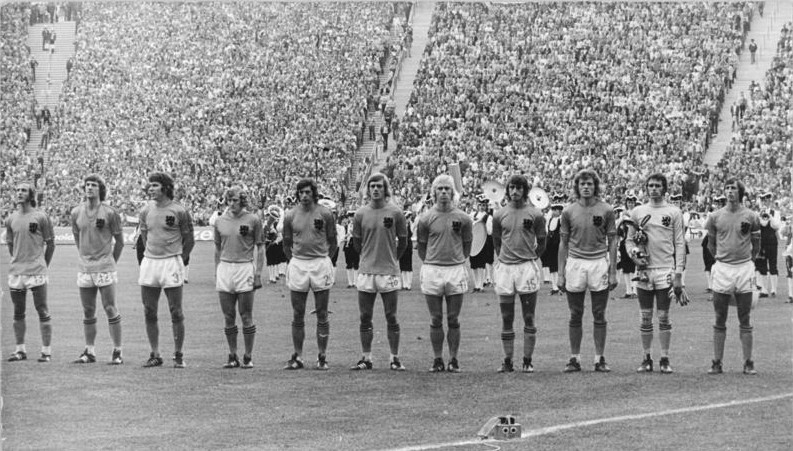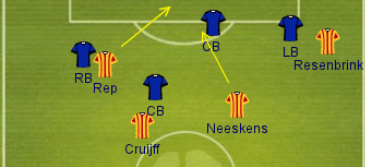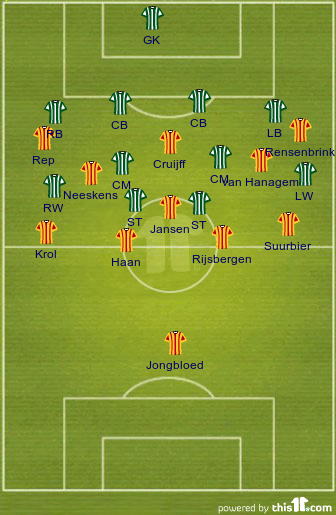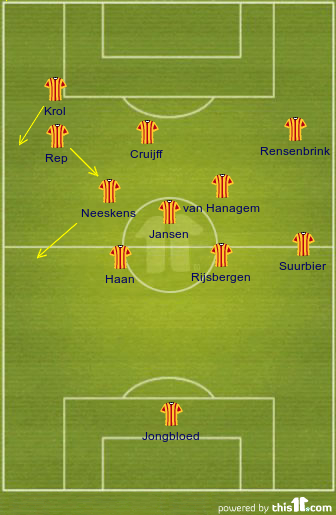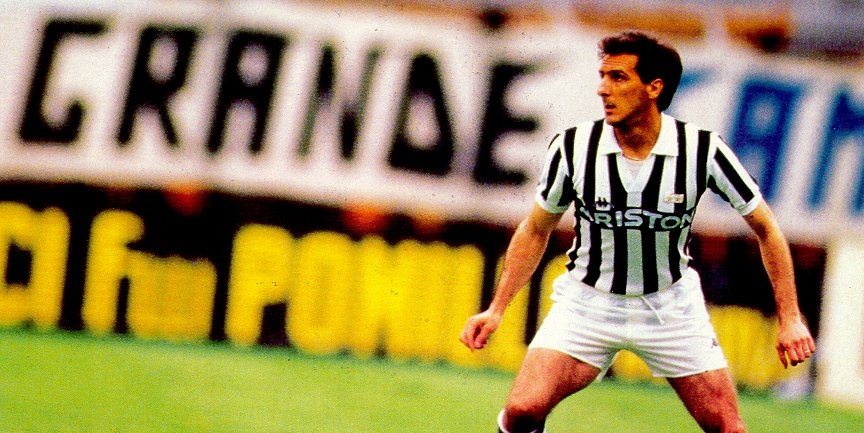With 1,259 people per square mile, Netherlands has one of the highest population densities in Europe, behind Monaco and San Marino. With the average density in Europe at 181 per square mile, the Dutch have always had to think innovatively with space, it’s land is one of the most intensively planned in the world, and it has to be, with around 419 houses in a square mile (if each house is home to three people).
 |
| Johan Cruijff – ‘Pythagoras in boots’ |
Rinus Michels brought the nation’s obsession over space into football with his idea of ‘flexible’ space. Now obviously the football pitch has the same amount of space on it than every other one, though through movement and positioning, the team can manipulate the amount of available space.
Michels’ method of defending came from how the Netherlands dealt with the Spanish attacks during the 16th century. The Dutch made the space between the walled cities as small as possible, by flooding the farmland in between, which was made easy by the fact that the majority of dutch land is below sea-level.
The Dutch are masters of space, and they are also great at ‘creating’ space where there was none before as well. They drained seas, swamps and lakes to create are to build, and pride themselves on the ability to make less tangible forms of space.
‘Flexible’ space can be used to attack and defend effectively, as well as conserving energy and controlling the opposition. Now space has always had an important role in football, but until Michel’sTotaal Voetbal side of the ’70s, no one thought about it.
Attacking – Creation of Space and Manipulation of Defenders
Probably the best aspect of the Netherlands side was their attacking ability, they had a brilliant attack in Cruijff, Rep and Resenbrink in a 4-3-3. Both Rep and Resenbrink were wingers, and played a big part in stretching the opposition defence, making as much space as possible for players like Cruijff and Neeskens to work with.
Notice how, with Rep and Resenbrink hugging the touchline, the opposition full-backs have to come wider to deal with them, meaning Cruijff has more room to work with as the defence have to defend wider, to match the wingers.
With the movement, Cruijff had a free role, but would drop deep, and Resenbrink and Rep could move inside. Against a man-marking defence, it could rip them apart as shown in the next picture.
Cruijff has dropped deep, bringing an opposition centre-back with him, this isolates the one centre-back on his own back in defence and creates space for other Netherlands players to move into, and as Neeskens makes the run from deep, and Rep cuts inside, he is left with two attackers to deal with.
In modern football, plays like this are very simple, with the popularisation of the false 9 by players like Messi and Totti (originally), the movement of strikers dropping deep is common now, but in the 70s, it was more uncommon and devastating against the man-marking defences.
Defending – Reduction of Space and Energy Conservation
The defending side of Totaal Voetbal is, in my opinion, much more interesting than the attacking aspects, because we don’t see it as much in today’s game and it’s a more unusual method than how other teams defended.
Consisting of a incredibly high defensive line and heavy pressing, Michels looked to use his ideas about space to defend, by trying to cut out as much of it as possible for the opposition to use. Unlike teams defending their goal, the Dutch side actually defended their halfway line, this already halved the amount of space that the opposition could use, the whole of Netherlands’ half.
As you can see, the opposition have barely any room to use, as Michels’ side pushes up and closes down the opponent vigorously, denying them time on the ball and space ahead of them.
An extremely aggressive offside trap and a ‘keeper higher up the pitch stopped the opposition from having many chances of 1-on-1s through balls over the top.
Energy Conservation
The high defensive line and constant rotation of positions meant the Dutch side had a lot of energy to play their brilliant football, as Ruud Krol explains in the book Brilliant Orange: The Neurotic Genius of Dutch Football by David Winner:
“Our system was also a solution to a physical problem. Fitness has to be one hundred per cent, but how can you play for 90 minutes and remain strong? If I, as left-back run 70 metres up the wing, it’s not good if i immediately have to run back 70 metres to my starting position. So, if the left-midfield player takes my place, and the left-winger takes the midfield position, then it shortens the distances. If you have to run ten times seventy metres, and the same distance back ten times, that’s a total of 1400 metres,. If you change it so you only must run 1000 metres, you will be 400 metres fresher. That was the philosophy.” There is another point in the book where Krol gives the explanation on how the defensive line helped them conserve more energy, “When we defended, we looked to keep the opponent on the halfway line. Our standpoint was that we were not protecting our own goal, we were attacking the halfway line. That’s why we played offside. You don’t want to run back to defend because you are trying to save energy. Instead of running 80 metres back and eighty forward, it’s better to run only ten in each direction. That’s 20 metres instead of 160.”
The fact that all of the players were of great quality meant they could all play many positions. If they weren’t good enough to be able to switch roles constantly during a match, the system would’ve failed but since everyone could near enough play everywhere (with a few exceptions), there could be defenders running up to be as high as Cruijff, and there would be no space for the opposition to exploit.
The extra energy from things like this meant that the Dutch side would be able to play at a high tempo whilst the opposition were tiring, giving de Oranje keutels the advantage. As the opposition grew tired and they remained energetic, more space opened up, and Netherlands could dominate teams start to finish.




















































